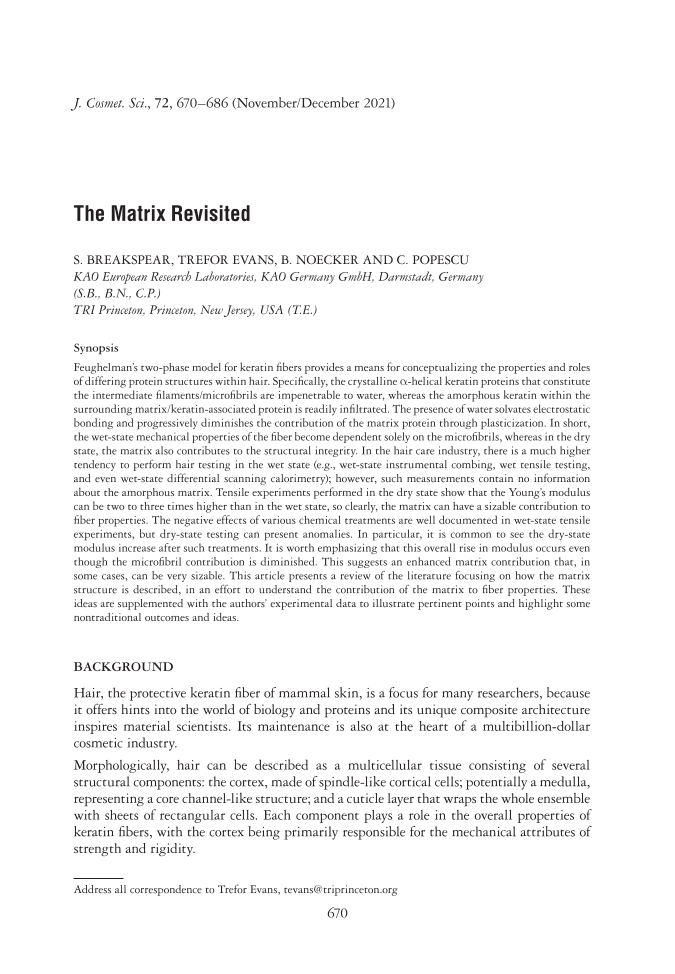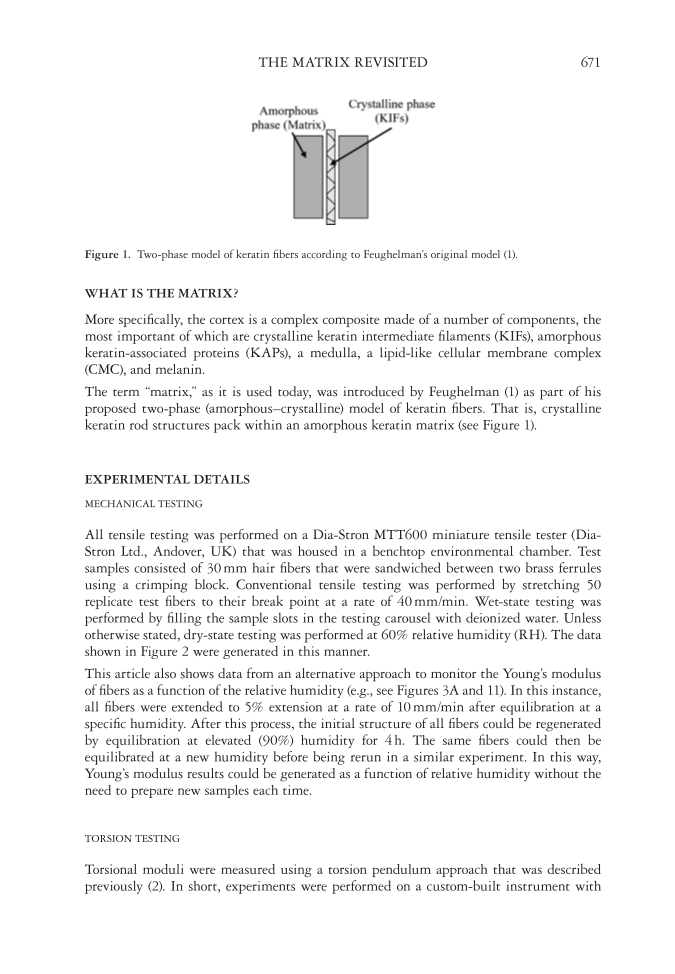670 Address all correspondence to Trefor Evans, tevans@triprinceton.org The Matrix Revisited S. BREAKSPEAR, TREFOR EVANS, B. NOECKER AND C. POPESCU KAO European Research Laboratories, KAO Germany GmbH, Darmstadt, Germany (S.B., B.N., C.P.) TRI Princeton, Princeton, New Jersey, USA (T.E.) Synopsis Feughelman’s two-phase model for keratin fibers provides a means for conceptualizing the properties and roles of differing protein structures within hair. Specifically, the crystalline α-helical keratin proteins that constitute the intermediate filaments/microfibrils are impenetrable to water, whereas the amorphous keratin within the surrounding matrix/keratin-associated protein is readily infiltrated. The presence of water solvates electrostatic bonding and progressively diminishes the contribution of the matrix protein through plasticization. In short, the wet-state mechanical properties of the fiber become dependent solely on the microfibrils, whereas in the dry state, the matrix also contributes to the structural integrity. In the hair care industry, there is a much higher tendency to perform hair testing in the wet state (e.g., wet-state instrumental combing, wet tensile testing, and even wet-state differential scanning calorimetry) however, such measurements contain no information about the amorphous matrix. Tensile experiments performed in the dry state show that the Young’s modulus can be two to three times higher than in the wet state, so clearly, the matrix can have a sizable contribution to fiber properties. The negative effects of various chemical treatments are well documented in wet-state tensile experiments, but dry-state testing can present anomalies. In particular, it is common to see the dry-state modulus increase after such treatments. It is worth emphasizing that this overall rise in modulus occurs even though the microfibril contribution is diminished. This suggests an enhanced matrix contribution that, in some cases, can be very sizable. This article presents a review of the literature focusing on how the matrix structure is described, in an effort to understand the contribution of the matrix to fiber properties. These ideas are supplemented with the authors’ experimental data to illustrate pertinent points and highlight some nontraditional outcomes and ideas. BACKGROUND Hair, the protective keratin fiber of mammal skin, is a focus for many researchers, because it offers hints into the world of biology and proteins and its unique composite architecture inspires material scientists. Its maintenance is also at the heart of a multibillion-dollar cosmetic industry. Morphologically, hair can be described as a multicellular tissue consisting of several structural components: the cortex, made of spindle-like cortical cells potentially a medulla, representing a core channel-like structure and a cuticle layer that wraps the whole ensemble with sheets of rectangular cells. Each component plays a role in the overall properties of keratin fibers, with the cortex being primarily responsible for the mechanical attributes of strength and rigidity. J. Cosmet. Sci., 72, 670–686 (November/December 2021)
671 THE MATRIX REVISITED WHAT IS THE MATRIX? More specifically, the cortex is a complex composite made of a number of components, the most important of which are crystalline keratin intermediate filaments (KIFs), amorphous keratin-associated proteins (KAPs), a medulla, a lipid-like cellular membrane complex (CMC), and melanin. The term “matrix,” as it is used today, was introduced by Feughelman (1) as part of his proposed two-phase (amorphous–crystalline) model of keratin fibers. That is, crystalline keratin rod structures pack within an amorphous keratin matrix (see Figure 1). EXPERIMENTAL DETAILS MECHANICAL TESTING All tensile testing was performed on a Dia-Stron MTT600 miniature tensile tester (Dia- Stron Ltd., Andover, UK) that was housed in a benchtop environmental chamber. Test samples consisted of 30 mm hair fibers that were sandwiched between two brass ferrules using a crimping block. Conventional tensile testing was performed by stretching 50 replicate test fibers to their break point at a rate of 40 mm/min. Wet-state testing was performed by filling the sample slots in the testing carousel with deionized water. Unless otherwise stated, dry-state testing was performed at 60% relative humidity (RH). The data shown in Figure 2 were generated in this manner. This article also shows data from an alternative approach to monitor the Young’s modulus of fibers as a function of the relative humidity (e.g., see Figures 3A and 11). In this instance, all fibers were extended to 5% extension at a rate of 10 mm/min after equilibration at a specific humidity. After this process, the initial structure of all fibers could be regenerated by equilibration at elevated (90%) humidity for 4 h. The same fibers could then be equilibrated at a new humidity before being rerun in a similar experiment. In this way, Young’s modulus results could be generated as a function of relative humidity without the need to prepare new samples each time. TORSION TESTING Torsional moduli were measured using a torsion pendulum approach that was described previously (2). In short, experiments were performed on a custom-built instrument with Figure 1. Two-phase model of keratin fibers according to Feughelman’s original model (1).
Purchased for the exclusive use of nofirst nolast (unknown) From: SCC Media Library & Resource Center (library.scconline.org)






































































































































